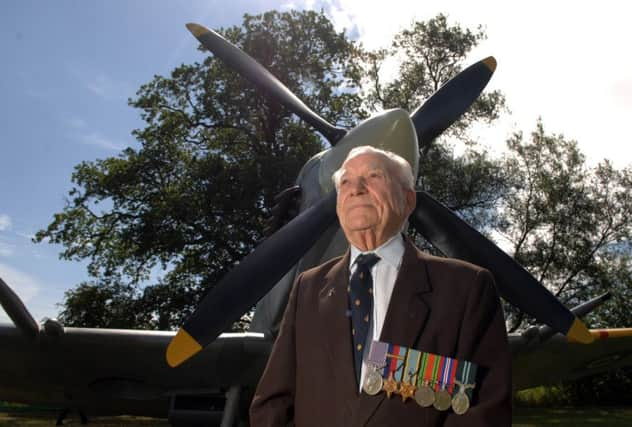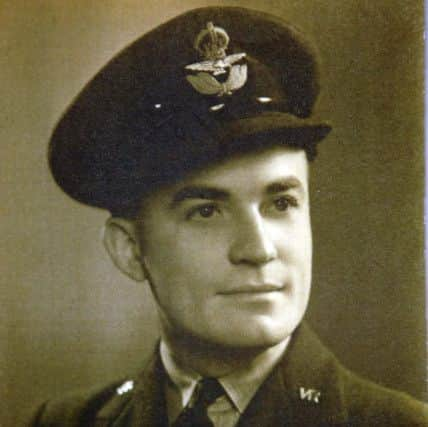The last of the ‘few’ Battle of Britain veterans


ON JUNE 18, 1940, Winston Churchill gave a rousing speech to the nation in which he said “... the Battle of France is over. The Battle of Britain is about to begin.”
It was the start of summer and Britain stood alone in solitary defiance against the Nazis who hitherto had crushed all opposition.
Advertisement
Hide AdAdvertisement
Hide AdThe battle began in mid-July and over the ensuing couple of months both Fighter Command and Bomber Command were pushed almost to breaking point as they held off the Luftwaffe’s onslaught and saved the country from invasion.


Afterwards, it was Churchill who again found the right words and spoke for a grateful nation when he said: “Never in the field of human conflict was so much owed by so many to so few.”
Today, 75 years after this crucial moment in our island’s history, the Few are an ever dwindling number and in Yorkshire it is believed there is only one.
Sergeant Terry Clark was 21 years old when the Battle of Britain began. Having initially joined the Auxiliary Air Force while he was still a teenager he was sent to 219 Squadron, a Blenheim fighter unit based at Catterick, in May 1940.
Advertisement
Hide AdAdvertisement
Hide AdFor many people, the Battle of Britain conjures images of dogfights in the skies with daring fighter pilots pitting their wits against the might of the Luftwaffe. But there is another side to the story.
By day the Spitfires and Hurricanes fought valiantly against the German fighters, but part of Hitler’s assault on our shores was a bombing war of attrition that required the total destruction of the RAF, paving the way for Operation Sea Lion – the invasion of Britain.
Some of these raids took place under the cover of darkness and the nightfighters in which Terry flew played a crucial role. As a qualified air gunner he was among those tasked with defending York and the surrounding airfields against night bombing raids by the Heinkels, Dorniers and Junkers.
After a few weeks his squadron was moved down to Redhill in Surrey where they switched from Blenheims to the Bristol Beaufighters, a two-seater nightfighter aircraft.
Advertisement
Hide AdAdvertisement
Hide AdTerry went from being an air gunner to a radar navigator. “We had radar navigators on the Blenheims but the vibration shook the radar equipment too much,” he says.
“Us air gunners didn’t really want to be twiddling knobs because we didn’t know anything about them. But we were told that we would learn on the job while we were flying,” he says. “At first I thought ‘I don’t like this’ but in the end it gets under your skin.”
Although the Luftwaffe appeared to have the numerical advantage in terms of the number of aircraft, the limited range of their planes and the fact they were fighting over enemy territory were both serious disadvantages. The RAF also had radar which proved to be a priceless tool for detecting enemy aircraft.
It was Terry’s job to track them. “I had two tubes and a beam and anything metal crossing into the beam I would pick up on my tubes.” One tube told him if an aircraft was above or below them and the other whether it was to the left or right.
Advertisement
Hide AdAdvertisement
Hide AdIt was intense, tiring work and one mistake could lead to you being shot out of the sky instead of the enemy. “It was interesting, especially for me, because, and I daren’t say this in front of a pilot, I was technically controlling the aircraft. The pilot would do exactly what I told him, either to climb a thousand feet or drop a thousand feet. It was my job to get our aircraft behind the enemy aircraft and as soon as my pilot could see it then it was down to him to shoot them down.”
Nightfighter crews slept during the day and flew during the hours of darkness and in between honed their card playing skills to relieve the boredom until the call came in to scramble.
He says you had to banish any thoughts about your own mortality to the back of your mind. “I didn’t think about the danger and I think it’s wise not to, because if you start thinking about the chance of being killed you might get worried and not do your job properly.”
As well as fighting the enemy flying new aircraft at night brought added risks and in the space of one week at his airfield two planes crash landed killing both sets of pilots and navigators.
Advertisement
Hide AdAdvertisement
Hide AdBut there was little time to mourn the friends and colleagues you lost. “The next time you were off duty and in the pub you would raise a pint to them,” he says.
The risk of the nightfighters being shot down was relatively low, unless they ventured across the Channel. “If we were chasing an aircraft the moment we were in enemy territory we were under instruction to drop off and come home, because you didn’t want to get shot down over enemy territory with your radar,” he says.
“There was one occasion when we shot an aircraft down and I suddenly noticed big puffs of smoke around our plane and the pilot said we were being fired at from the ground. I said ‘Put the nose down and let’s get out quick.’”
During another encounter they intercepted a couple of German bombers. “There were two of them from a special German bombing squad and we destroyed the first one and saw it crash on the ground. There was a mighty explosion and I remember thinking ‘My God, what was he carrying?’
Advertisement
Hide AdAdvertisement
Hide Ad“We located the second aircraft and my pilot was about to start shooting when all of a sudden he said ‘bloody hell’ and the aircraft blew up in front of us. Bits of the fuselage started peppering us and I just prayed it didn’t hit our propellers.”
They found out later from intelligence officers that the bombers were on their way to attack Chatham, home to a key naval station. “We saved a lot of sailors and no doubt the village, which is next door would have been hit, so we probably saved quite a lot of lives that night.”
Now 96, Terry, who lives near York, is still as sharp as a tack and looking back 75 years on is proud of the part he played in the Battle of Britain. But he shakes his head when I suggest he’s a hero in the eyes of many people. “If you want a hero think of the bomber boys, because they were going across to Germany not knowing if they were going to come back.”
He still misses his friends, like Squadron Leader Dudley Hobbis, who didn’t make it, but says that was the price they paid for the freedom we all enjoy today.
Advertisement
Hide AdAdvertisement
Hide Ad“We destroyed enemy bombers as fast as we could along with the fighter boys and we managed to keep them at bay. If all of us hadn’t done what we had to do and done it willingly then you and I would probably be speaking German, because there’s no doubt an invasion was coming,” he says.
“But we don’t feel like heroes, we were just doing our job.”
Defenders of the nation
The Battle of Britain will forever be associated with the brave pilots, from 14 nations, of Fighter Command. But they weren’t alone in defending the nation from the Nazis. With the loss of 998 aircrew, RAF Bomber Command and Coastal Command suffered heavier losses during the period of the Battle of Britain than the 544 pilots of Fighter Command.
It is also worth remembering that Winston Churchill’s famous speech, in which he stated that “never in the field of human conflict has so much been owed by so many to so few” was directed at all British and Allied aircrews.
Churchill recognised that it was the bomber crews, undertaking their deadly missions to destroy enemy airfields and factories, that bore the brunt of the burden on the Air Force.